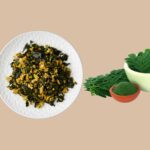Table of Contents
Lettuce and spinach are two of the most popular salad greens, often used interchangeably. But there are some key differences when it comes to nutrition profile, taste, texture, and how they are best used in recipes. In this article, we compare and contrast ‘lettuce vs spinach’ to help you decide when to use each.
Introducing Lettuce VS Spinach
Lettuce and spinach are both leafy vegetables that have been cultivated and eaten for thousands of years. Lettuce comes from the daisy family, while spinach is related to beets and quinoa. There are many varieties of lettuce like iceberg, romaine, bibb, etc. and spinach types like curly leaf or baby spinach. Both pack vitamins, minerals, antioxidants and other nutrients in their fresh, tender leaves. But spinach does edge out lettuce when it comes to overall nutrition content.
Comparing Nutrition Profiles
Calorie-wise, lettuce has the advantage. One cup of lettuce greens contains just 10-20 calories depending on variety. Spinach contains about 7 calories per cup of raw leaves. Where spinach pulls ahead is offering higher amounts of fiber, protein, vitamins and minerals per calorie. Spinach contains triple the amount of vitamin K, five times more vitamin A, and significantly more folate and iron than most types of lettuce. It’s also a non-heme source of iron. So while lettuce makes a great low calorie base, spinach offers a powerhouse of additional nutrients.
Related: How many calories are in a chicken caesar salad
Looking at Vitamin and Mineral Content
Some key areas where spinach beats out lettuce in nutritional content:
Vitamin A: Spinach has over 2500% DV per 100 grams versus 7% DV in lettuce
Vitamin K: Spinach has over 600% DV versus 52% DV in lettuce
Folate: Spinach has 49% DV versus 7% in lettuce
Iron: Spinach has 20% DV versus 5% in lettuce
Analyzing Protein, Fiber and Carbs
Fiber is crucial for digestion and heart health. Spinach contains 2 grams of fiber per 100 grams – double the amount of fiber in lettuce. Spinach also wins when it comes to protein content. It has about 3 grams of protein per 100 grams, while lettuce only has 1 gram of protein. For those tracking carbs, you do get fewer grams of carbs and sugar eating lettuce versus spinach. But spinach compensates with its dense nutrition.
Related: How many calories in one slice of white bread
Breaking Down Leafy Green Benefits
Both lettuce and spinach provide valuable antioxidants like vitamin C, beta carotene, quercetin and lutein. These can help reduce oxidative stress and inflammation in the body. As low calorie vegetables, they can help displace less healthy foods and may potentially reduce disease risks including obesity, heart disease, and diabetes according to some studies. Spinach does seem to boast more significant health benefits, but both are praised for their nutrient contents.
Contrasting Flavor and Texture
Lettuce is prized for its mild, slightly sweet flavor and crisp, refreshing crunch that adds great texture contrast in salads and sandwiches. Spinach has a more grassy, earthy, slightly bitter taste, especially when raw. It also has a more delicate texture that wilts when exposed to heat. So the two greens do differ quite a bit when it comes to flavor profile and how they are best enjoyed.
Popularity and Usage
Iceberg lettuce is the most popular salad green, typically paired with ranch dressing in simple green salads and on sandwiches or tacos. Romaine is also widely used in Caesar salad. Spinach is rarely served raw on its own, but commonly cooked down in dishes like quiches, casseroles, pasta, soups and as a pizza topping. It’s also used raw in green smoothies. Both work well in wraps or spring rolls. Lettuce is the go-to for that fresh crunch in burgers and sandwiches.
Comparing Homegrown Lettuce and Spinach
If planning to grow your own lettuce and spinach, here are some tips. Lettuce thrives in cool weather and full sun. Grow different varieties for continuous harvest. Spinach grows best in early spring and fall in half sun or light shade. It bolts quickly in summer heat. Lettuce can be grown close together while spinach needs more room to mature. Lettuce gives multiple cuttings while spinach has a shorter growing window.
Related: How many calories are in a chef salad?
Storing and Preparing Lettuce vs. Spinach
Always wash greens well before use. Lettuce keeps longer than spinach when stored properly. Once washed, dry lettuce leaves completely and they’ll stay fresh in the fridge up to 10 days. Spinach is more delicate – store dry leaves just 2-3 days. Cook spinach to reduce oxalic acid content. Lettuce is typically eaten raw. Discard outer leaves if they appear wilted or slimy.
Using Lettuce and Spinach in Recipes
Crisp lettuce leaves are perfect wraps for tacos or other fillings. Shredded lettuce makes a classic base for burgers or salads paired with creamy dressings. Mild lettuce combines well with bold ingredients. Spinach is better cooked – lightly sauteed with olive oil and garlic or blended raw into green smoothies. Heartier spinach can be baked into casseroles or lasagna. Use both lettuce and spinach in combo for ideal texture and nutrition.
Related: How many calories are in spring mix
Deciding Between Lettuce and Spinach
The choice depends on your specific recipe, taste preferences, and nutrition goals. Lettuce gives crunch and mild refreshing flavor. Spinach offers more nutrients but also stronger green flavor. Mixing the two gives you the best of both worlds. Spinach substitutes well for lettuce in wraps or sandwiches when you want bolder taste. Lettuce works better raw in things like salad or coleslaw where you want to maintain crispness.
Possible Concerns and Food Safety
Lettuce is prone to bacterial contamination and needs proper handling. Discard any questionable leaves or liquid at bag bottom. Spinach contains oxalates that can cause kidney stones in predisposed people. Cooking helps decrease oxalates. Both greens are very safe when grown properly or purchased from reputable sources and used by date. Avoid it if you have an allergy.
Explore Different Varieties
Try out different lettuces like crisphead, romaine, butterhead and loose leaf varieties. Spinach also comes in savoy, semi-savoy or flat leaf types. Baby spinach is perfect for smoothies. Mix various greens together for diversity of flavors and nutrition.
A Word From Blogzah
While both nutritious low calorie salad greens, spinach offers more protein, fiber, vitamins and minerals than lettuce. But the tender crunch of lettuce is perfect in its raw state for certain uses like tacos, burgers and salads. For added nutrition, using both lettuce and spinach together gives you the ideal combination.
















